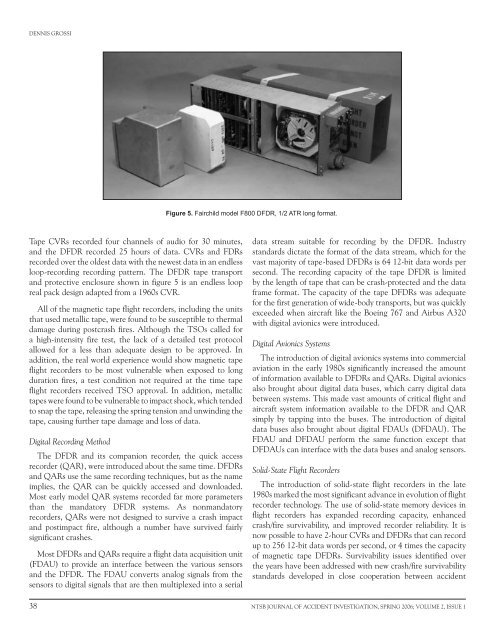Journal of Accident Investigation
Journal of Accident Investigation
Journal of Accident Investigation
You also want an ePaper? Increase the reach of your titles
YUMPU automatically turns print PDFs into web optimized ePapers that Google loves.
DENNIS GROSSI<br />
Tape CVRs recorded four channels <strong>of</strong> audio for 30 minutes,<br />
and the DFDR recorded 2 hours <strong>of</strong> data. CVRs and FDRs<br />
recorded over the oldest data with the newest data in an endless<br />
loop-recording recording pattern. The DFDR tape transport<br />
and protective enclosure shown in figure is an endless loop<br />
real pack design adapted from a 1960s CVR.<br />
All <strong>of</strong> the magnetic tape flight recorders, including the units<br />
that used metallic tape, were found to be susceptible to thermal<br />
damage during postcrash fires. Although the TSOs called for<br />
a high-intensity fire test, the lack <strong>of</strong> a detailed test protocol<br />
allowed for a less than adequate design to be approved. In<br />
addition, the real world experience would show magnetic tape<br />
flight recorders to be most vulnerable when exposed to long<br />
duration fires, a test condition not required at the time tape<br />
flight recorders received TSO approval. In addition, metallic<br />
tapes were found to be vulnerable to impact shock, which tended<br />
to snap the tape, releasing the spring tension and unwinding the<br />
tape, causing further tape damage and loss <strong>of</strong> data.<br />
Digital Recording Method<br />
The DFDR and its companion recorder, the quick access<br />
recorder (QAR), were introduced about the same time. DFDRs<br />
and QARs use the same recording techniques, but as the name<br />
implies, the QAR can be quickly accessed and downloaded.<br />
Most early model QAR systems recorded far more parameters<br />
than the mandatory DFDR systems. As nonmandatory<br />
recorders, QARs were not designed to survive a crash impact<br />
and postimpact fire, although a number have survived fairly<br />
significant crashes.<br />
Most DFDRs and QARs require a flight data acquisition unit<br />
(FDAU) to provide an interface between the various sensors<br />
and the DFDR. The FDAU converts analog signals from the<br />
sensors to digital signals that are then multiplexed into a serial<br />
Figure 5. Fairchild model F800 DFDR, 1/2 ATR long format.<br />
data stream suitable for recording by the DFDR. Industry<br />
standards dictate the format <strong>of</strong> the data stream, which for the<br />
vast majority <strong>of</strong> tape-based DFDRs is 64 12-bit data words per<br />
second. The recording capacity <strong>of</strong> the tape DFDR is limited<br />
by the length <strong>of</strong> tape that can be crash-protected and the data<br />
frame format. The capacity <strong>of</strong> the tape DFDRs was adequate<br />
for the first generation <strong>of</strong> wide-body transports, but was quickly<br />
exceeded when aircraft like the Boeing 767 and Airbus A320<br />
with digital avionics were introduced.<br />
Digital Avionics Systems<br />
The introduction <strong>of</strong> digital avionics systems into commercial<br />
aviation in the early 1980s significantly increased the amount<br />
<strong>of</strong> information available to DFDRs and QARs. Digital avionics<br />
also brought about digital data buses, which carry digital data<br />
between systems. This made vast amounts <strong>of</strong> critical flight and<br />
aircraft system information available to the DFDR and QAR<br />
simply by tapping into the buses. The introduction <strong>of</strong> digital<br />
data buses also brought about digital FDAUs (DFDAU). The<br />
FDAU and DFDAU perform the same function except that<br />
DFDAUs can interface with the data buses and analog sensors.<br />
Solid-State Flight Recorders<br />
The introduction <strong>of</strong> solid-state flight recorders in the late<br />
1980s marked the most significant advance in evolution <strong>of</strong> flight<br />
recorder technology. The use <strong>of</strong> solid-state memory devices in<br />
flight recorders has expanded recording capacity, enhanced<br />
crash/fire survivability, and improved recorder reliability. It is<br />
now possible to have 2-hour CVRs and DFDRs that can record<br />
up to 2 6 12-bit data words per second, or 4 times the capacity<br />
<strong>of</strong> magnetic tape DFDRs. Survivability issues identified over<br />
the years have been addressed with new crash/fire survivability<br />
standards developed in close cooperation between accident<br />
38 NTSB JOURNAL OF ACCIDENT INVESTIGATION, SPRING 2006; VOLUME 2, ISSUE 1
















